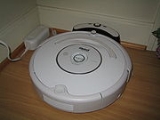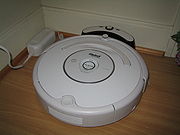
Product design
Encyclopedia

Introduction
Product design is the process of creating a new product to be sold by a business or enterprise to its customers. It is concerned with the efficient and effective generation and development of ideas through a process that leads to new products.Product designers conceptualize and evaluate ideas, making them tangible through products in a more systematic approach. Their role is to combine art, science and technology to create tangible three-dimensional goods. This evolving role has been facilitated by digital
Digital
A digital system is a data technology that uses discrete values. By contrast, non-digital systems use a continuous range of values to represent information...
tools that allow designers to communicate, visualize and analyze ideas in a way that would have taken greater manpower
Manpower
Manpower may refer to:*Human resourcesOrganizations:*Manpower Inc., an international employment agency, headquartered in the United States*Manpower Incorporated, a criminal enterprise in the Honor Harrington science fiction series...
in the past.
Product design is sometimes confused with industrial design, industrial design is concerned with the aspect of that process that brings that sort of artistic form and usability usually associated with craft design to that of mass produced goods.
Design Process
The design process is the transformation of an idea, needs, or wants by consumers or the marketplace at large, into a product that satisfies these needs. This is usually accomplished by adventurous people that are willing to take it on. Sometimes an engineer will be involved on some levels but not always. Product designers follow various [methodology] that requires a specific skill set (usually in engineering) to complete.Design is basically a problem solving exercise. The design of a new product consists of the following stages:
- Design Brief
- Product Design Specifications
- Concept Design
- Testing
- Detail Design
- Manufacturing and Further Testing
- Refinement and Sales
Initial stage
- Idea Generation can be from imaginationImaginationImagination, also called the faculty of imagining, is the ability of forming mental images, sensations and concepts, in a moment when they are not perceived through sight, hearing or other senses...
, observationObservationObservation is either an activity of a living being, such as a human, consisting of receiving knowledge of the outside world through the senses, or the recording of data using scientific instruments. The term may also refer to any data collected during this activity...
, or researchResearchResearch can be defined as the scientific search for knowledge, or as any systematic investigation, to establish novel facts, solve new or existing problems, prove new ideas, or develop new theories, usually using a scientific method...
. - Need Based Generation can be from the need to solve a problem, the need to follow the popular trends, or the need for a product to do a specific task.
Mid stage
- Design Solutions arise from meeting user needs, concept development, form exploration, ergonomics, prototyping, materials, and technology.
- Production involves fabrication and manufacturingManufacturingManufacturing is the use of machines, tools and labor to produce goods for use or sale. The term may refer to a range of human activity, from handicraft to high tech, but is most commonly applied to industrial production, in which raw materials are transformed into finished goods on a large scale...
the design.
Final stage
- Marketing involves selling the product. It can either be client based which mean the a client buys the design and manufactures it and then sells it to customers. Or it can be user based where the product is sold directly to the user by the designer.
Application
Product design ranges from furniture, electronics, lighting, tools, toys, and general everyday objects.For new products product design is of six important steps:
1. customer needs identification
2. conceptualization
3. system level design
4. Detailed design
5. Testing and refinement
6. Production ramp up
Future trends
The design of products of every type is clearly linked to the economic health of manufacturing sectors...Innovation provides much of the competitive impetus for the development of new products, with new technology often requiring a new design interpretation. It only takes one manufacturer to create a new product paradigm to force the rest of the industry to catch up - fuelling further innovation.See also
- Industrial designIndustrial designIndustrial design is the use of a combination of applied art and applied science to improve the aesthetics, ergonomics, and usability of a product, but it may also be used to improve the product's marketability and production...
- Axiomatic product development lifecycleAxiomatic product development lifecycleThe Axiomatic Product Development Lifecycle in systems engineering is a model developed by Bulent Gumus in 2005. This new model is based on the Axiomatic design method developed by MIT Professor Nam P. Suh since the 1990s ; hence it inherits the benefits of applying the Axiomatic Design to product...
APDL
External links
- The International Development Design Summit - designing "products" for developing world

